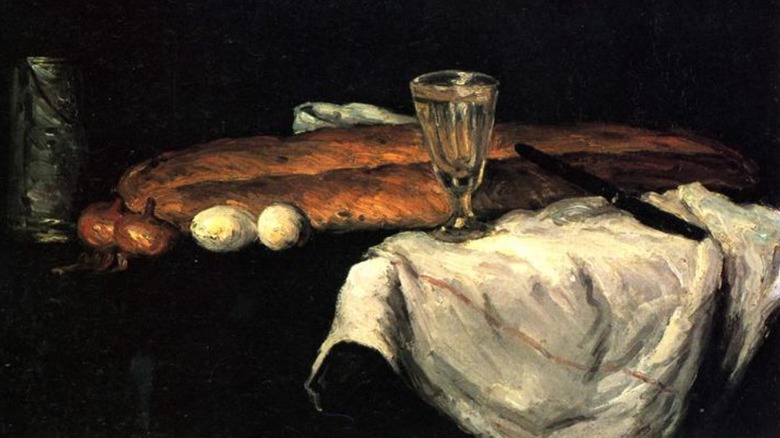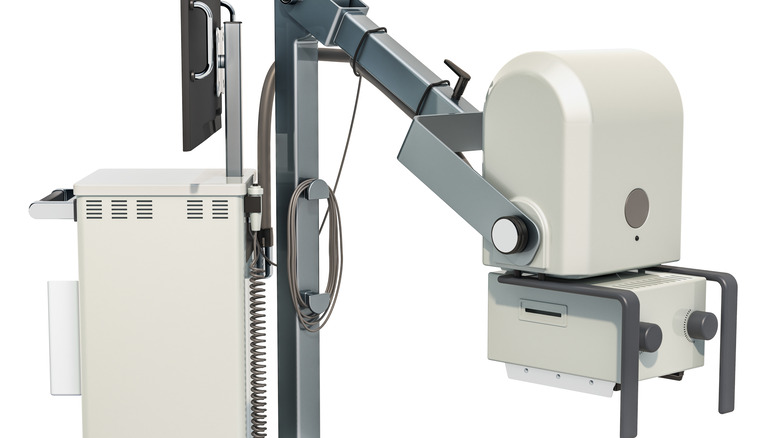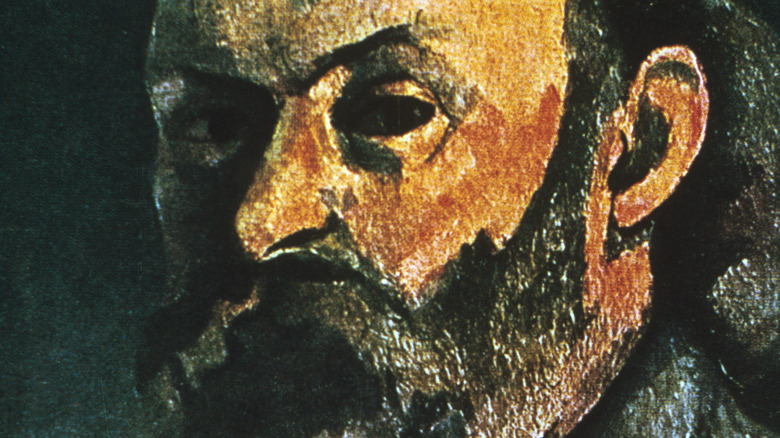The Stunning Discovery Made Under The Surface Of A 160-Year-Old Painting
Born in Aix-en-Provence, France in 1839, Post-impressionist artist Paul Cézanne became famous for the bright colors of his whimsical still lives, structural landscapes, and sympathetic portraits of ordinary French people (via The Met). But he may have hidden one of his most fascinating works beneath layers of paint. On December 15, 2022, Cincinnati Art Museum chief conservator Serena Urry announced that she had discovered a second painting underneath the 1865 Cézanne work "Still Life with Bread and Eggs."
Cézanne completed the still life early in his career when he still used a darker color palette, according to The Met. The painting features two baguettes on top of a table and a crumpled white table cloth. To the left of the baguettes rest two onions and two eggs. In front of the bread stands an empty goblet. As described by Urry, "a portrait of a man, perhaps a self-portrait of Cézanne," rests beneath the domestic scene. "The portrait underneath was painted the same year—or even earlier—making it one of the earliest known portraits by Cézanne," Urry wrote in the museum blog post announcing the find, which also detailed how she uncovered the hidden artwork.
Discovering the painting under the painting
Serena Urry doesn't make a habit of looking for hidden paintings in her museum's collection. Instead, she found out about the mystery man through a "routine inspection" of the still life, according to CNN. During the examination, Urry noticed a strange arrangement of cracks on the painting's surface, she wrote on the Cincinnati Art Museum blog. Usually, old paintings boast cracks on the full canvas, but these were in just two spots and edged in white, Urry told CNN. "I thought there might be something underneath that we should look at," she said.
To find out, Urry turned to the sciences. She had a medical company examine the painting with a portable X-ray machine. Then, she spent some time pondering the resulting images. Finally, she "turned [the painting] 90 degrees" and realized that the X-ray had revealed the ghostly image of a man. "This is a huge discovery," Cincinnati Art Museum curator of European paintings, sculpture, and drawings Peter Jonathan Bell, Ph.D. said in a statement reported by WLWT5. Visitors to the museum can now see the original artwork alongside the X-ray findings.
Paul Cézanne's earliest self-portrait?
Serena Urry and her team believe that the newly revealed painting is actually a self-portrait of Paul Cézanne. "He's posed in the way a self-portrait would be: in other words, he's looking at us, but his body is turned," Urry explained to CNN. A self-portrait would be a significant find because the artist would have been in his 20s when he painted it, making it one of the first known images discovered of the man.
Other details continue to elude the curators. They don't know what colors Cézanne employed, how far he got in the portrait, or why he chose to abandon it and start over with a new painting on the same canvas. It's possible that he did not like the original outcome, that he didn't have money for a new canvas, or that he painted over it in a fit of inspiration. "We are at the outset of the process of discovering as much as we can about the portrait," Peter Jonathan Bell told CNN. The museum plans to collaborate with other experts in the field and take advantage of additional imaging techniques to glean further information.


